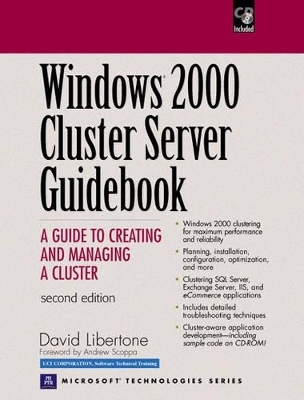
Windows 2000 Cluster Server Guidebook
Prentice Hall
978-0-13-028469-3 (ISBN)
- Titel ist leider vergriffen;
keine Neuauflage - Artikel merken
PLEASE PROVIDE
Microsoft's Windows 2000 Server clustering solutions enable enterprises to dramatically improve the availability, scalability, and manageability of virtually any business-critical system. Windows 2000 Cluster Server Guidebook is the first book to deliver expert, start-to-finish guidance for planning, deploying, and managing Windows 2000 clusters. Libertone starts by reviewing Windows 2000's key clustering concepts and architecture, and the key issues associated with deploying clustering in the enterprise. Walk through building a cluster, mastering failover, load balancing, dual-NIC cluster configurations, Fibre Channel-based clusters, and more. Review real-world cluster configuration and deployment in SQL Server, Exchange Server, and IIS Web/eCommerce applications; then, learn how to manage clustering from both the Cluster Administrator utility and the command line. Libertone helps readers choose the best hardware platforms for clustering, and even presents hard-to-find information and sample code for cluster-aware application development using Microsoft's new clustering APIs.
MR. DAVID LIBERTONE has more than 15 years' experience in the computer industry as a data center manager and instructor. In 1992, he was one of the first certified professionals to teach Windows NT (while in its original beta version). He is co-founder and chairperson of the Microsoft Windows Developer User Group and Senior Systems Engineer for UCI Software Technical Training in Woburn, Massachusetts (www.ucitraining.com). His previous books include Windows NT Cluster Server Guidebook and E-Commerce Solutions Using Microsoft Commerce Server 3 (Prentice Hall PTR).
1. The Data Processing Dilemma.
Current Potential Solutions. UPS. Disk Redundancy. Transaction Processing. Replication Servers. Multiprocessors. The Requirements. Microsoft Cluster Solutions.
2. What Is a Cluster?
Clustering Solutions. Active/Passive. Active/Active. Cluster Models. Shared Resource Cluster Model. Distributed Lock Manager. Shared Nothing Cluster Model. The Quorum Resource. An Architectural Overview of Microsoft Cluster Software. The Database Manager. The Event Processor. The Node Manager. The Communications Manager. The Global Update Manager. The Resource Manager. Resource Monitors. Virtual Server.
3. Building a Cluster.
Designing a Cluster. Hardware Requirements. Windows 2000 Advanced Server-Hardware Requirements. Windows 2000 Cluster Service Hardware Requirements. Software Requirements. Windows 2000 Advanced Server. Upgrading to Windows 2000 on Cluster Nodes. Overview of Rolling Upgrades. Installing the Cluster Service. Preliminary Steps. Removing the Cluster Service.
4. Implementing Cluster Resources.
Group Objects. Groups Defined. Standard Cluster Groups. Planning Groups. Creating Groups. Working with Groups. Resource Objects. Resources Defined. Standard Cluster Resources. Working with Resources. The Initiate Failure Option. Common Resource Properties. The IP Address Resource. What Is an IP Address Resource? A Short Discussion on TCP/IP. Creating an IP Address Resource. The Cluster IP Address Resource. The Network Name Resource. Network Names Defined. Creating a Network Name Resource. The File Share Resource. What Is a File Share? Creating Multiple File Shares with One Resource. What Happens During a Failover. The Print Spooler Resource. Print Spooler Resource Defined. Creating a Print Spooler Resource. Configuring Cluster Print Devices. The Generic Service Resource. What Is a Service? Service Resource in Microsoft Cluster Server. Configuring a Generic Service Resource. The Generic Application Resource. Generic Application Resource Defined. Creating a Generic Application Resource. The Physical Disk Resource. The Physical Disk Resource Defined. Creating a Physical Disk Resource. The IIS Server Instance Resource. Creating an IIS Server Instance Resource. The DHCP Server Resource. The Distributed Transaction Coordinator Resource. The Distributed Transaction Coordinator Defined. Resource Managers. Transaction Managers.
5. Cluster Management.
The Cluster Administrator Utility. Cluster Administrator Options. Cluster Object. Cluster Properties. Managing Cluster Nodes. Pause Node. Evict Node. Start/Stop Cluster Service. Managing Cluster Security. Cluster.exe 123 Administrative Tasks. Cluster Backup and Restore. Backing Up Data on the First Cluster Node. Backing Up Data on Remaining Cluster Nodes. Restoring Data on a Server Cluster Node. Performing a Hardware Upgrade. Performing a Software Upgrade.
6. Clustering SQL Server.
SQL Server-Overview. Devices and Databases. Microsoft Cluster Support for SQL Server. Symmetric Virtual Server. Active/Passive Configuration. Active/Active Configuration. Installing SQL Server, Enterprise Edition 6.5. Installing Cluster Support for SQL Server. Pre-Setup Requirements. Cluster Support for SQL Server-Setup. Cluster Support for SQL Server Modifications. Clustering SQL Server 7.0.
7. Clustering Exchange Server.
Exchange Server-Overview. Installing Exchange Server, Enterprise Edition. Pre-Setup Considerations. Setup-Primary Cluster Node. Setup-Secondary Cluster Node. Replacing an Existing Exchange Server. Supporting Exchange Server, Enterprise Edition. Administration-Operational Differences.
8. Network Load Balancing Clusters.
Introduction. Overview of Network Load Balancing Configuration. Database Access from Load-Balanced Server Applications. How Network Load Balancing Works. Distribution of Cluster Traffic. Convergence.
9. Cluster Troubleshooting.
Troubleshooting Tools. Disk Administration. Task Manager. Services Tool. Event Viewer. Net Helpmsg. Net View. Ping Utility. Network Monitor. System Information. Cluster Logging. Sample Cluster Log. Cluster Troubleshooting. Windows 2000 Configuration Checklist. Windows 2000 Procedure Checklist. Installation Problems. SCSI Device Problems. Cluster Member Connectivity Problems. Client-Cluster Connectivity Problems. Group and Resource Failure Problems. General Cluster Issues. Troubleshooting by Resource Type.
10. The Cluster API.
Network Management Functions. CloseClusterNetwork. ClusterNetworkCloseEnum. ClusterNetworkEnum. ClusterNetworkOpenEnum. ClusterNetworkControl. GetClusterNetworkState. OpenClusterNetwork. SetClusterNetworkName. SetClusterNetworkPriorityOrder. Cluster Management Functions. CloseCluster. CloseClusterNotifyPort. ClusterCloseEnum. ClusterEnum. ClusterOpenEnum. ClusterResourceTypeControl. CreateClusterNotifyPort. CreateClusterResourceType. DeleteClusterResourceType. GetClusterInformation. GetClusterNotify. GetClusterQuorumResource. OpenCluster. RegisterClusterNotify. SetClusterName. SetClusterQuorumResource. Resource Group Management Functions. CloseClusterGroup. ClusterGroupCloseEnum. ClusterGroupControl. ClusterGroupEnum. ClusterGroupOpenEnum. CreateClusterGroup. DeleteClusterGroup. GetClusterGroupState. MoveClusterGroup. OfflineClusterGroup. OnlineClusterGroup. OpenClusterGroup. SetClusterGroupName. SetClusterGroupNodeList. Resource Management Functions. AddClusterResourceDependency. AddClusterResourceNode. CanResourceBeDependent. ChangeClusterResourceGroup. CloseClusterResource. ClusterResourceCloseEnum. ClusterResourceControl. ClusterResourceEnum. ClusterResourceOpenEnum. CreateClusterResource. DeleteClusterResource. FailClusterResource. GetClusterResourceNetworkName. GetClusterResourceState. OfflineClusterResource. OnlineClusterResource. OpenClusterResource. RemoveClusterResourceNode. RemoveClusterResourceDependency. SetClusterResourceName. A Sample Application.
APPENDIX A: Resource Dependency Table.
APPENDIX B: System Performance.
Analyzing System Performance. Memory. Performance Monitor. Analyzing Disk Activity. Analyzing Processor Activity. Analyzing Network Activity. Cluster Performance.
Glossary.
Index.
About the CD.
| Erscheint lt. Verlag | 14.6.2000 |
|---|---|
| Verlagsort | Upper Saddle River |
| Sprache | englisch |
| Maße | 179 x 233 mm |
| Gewicht | 657 g |
| Themenwelt | Informatik ► Betriebssysteme / Server ► Windows |
| Informatik ► Betriebssysteme / Server ► Windows Server | |
| Informatik ► Weitere Themen ► Hardware | |
| ISBN-10 | 0-13-028469-6 / 0130284696 |
| ISBN-13 | 978-0-13-028469-3 / 9780130284693 |
| Zustand | Neuware |
| Haben Sie eine Frage zum Produkt? |